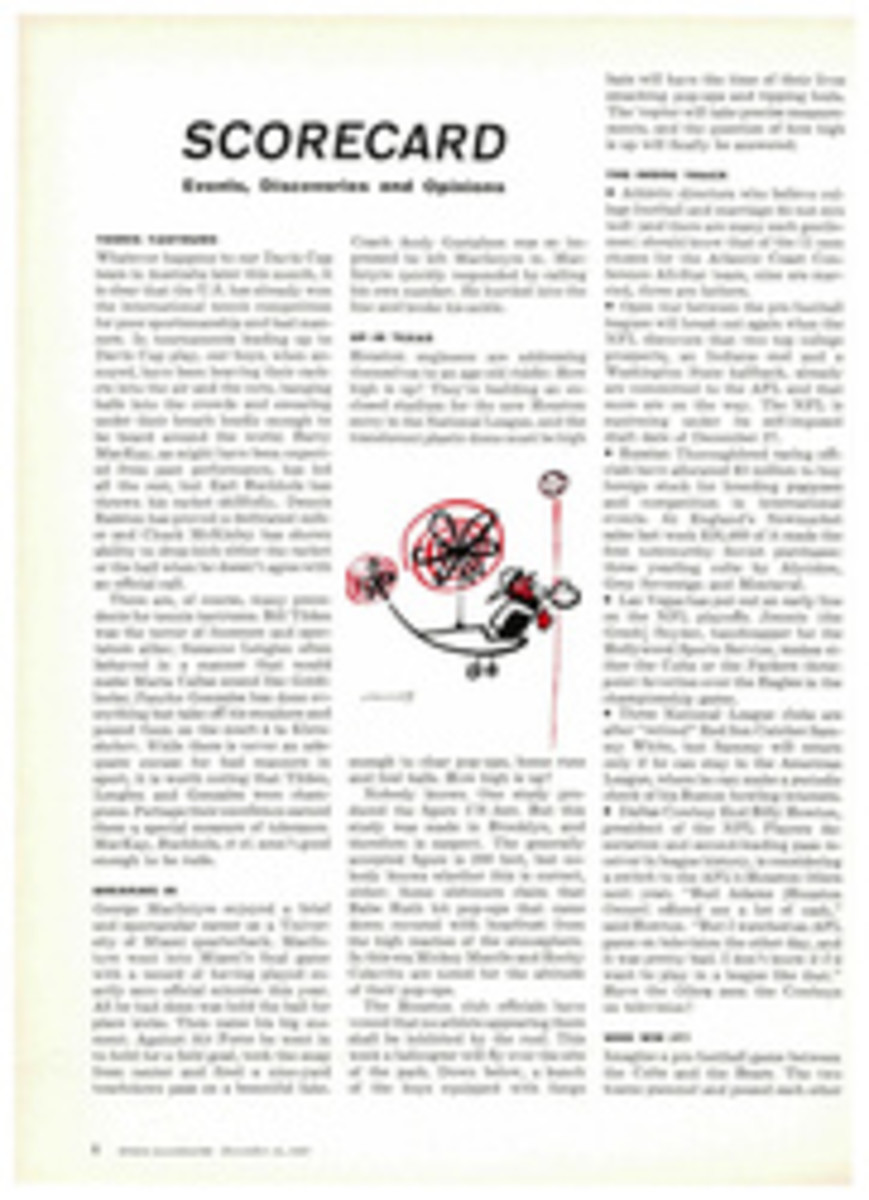
POINT OF FACT
? When did modern ski jumping begin?
•In 1840 a Norwegian named Sondre Nordheim made the first leap off a jump onto a steep slope. Previously jumpers landed only on fairly level surfaces.
? Where was the first ski-jump competition held?
•The first systematic jump meet took place on Huseby hill near Oslo in 1879. Earlier meets in the 1860s were haphazard affairs, with some of the races a combination of jumping and downhill running.
? Where were the first Alpine races?
•Military competitions were held in Norway as early as 1774. In the U.S., gold miners competed in races in the Sierras in the 1860s. They used 12-foot skis and reached speeds of 88 miles per hour. The sport died out, however, after the mines closed down. The first nonmilitary downhill competition in Europe was held outside Oslo in 1866. Sweden became the second European country to hold downhill races when schoolboys competed in 1877. The racers went between markers or poles and ended on a frozen lake; the winner was the boy who slid the farthest out on the ice. The first races in the Alps were held in 1893 at Styria, Austria and at Seebuck, Germany in 1896. Modern Alpine racing began with the development of control gates for setting a course by Mathias Zdarsky in 1905. However, Sir Arnold Lunn set up the first slalom race, as we know it, in 1922 at M√ºrren, Switzerland.
? What is the technical difference between the three modern types of racing: slalom, giant slalom and downhill?
•In the slalom, the skier usually runs ½ to ¾ of a mile between 40 to 75 sets of poles, each set known as a gate. (The course has a vertical drop anywhere from 395 to 722 feet.) The skier may knock down a pole, but his boot must still pass inside the pole. If one boot passes outside, the skier is disqualified. In the giant slalom, the course is usually between one and two miles long and drops at least a quarter of a mile. There are some 30 gates, with no gate less than 13 feet wide. The skier is disqualified if one of his boots passes outside a gate but, as in all ski races, if he falls, he may recover and continue the race. The third type, the downhill race, is an all-out run, with only an occasional control gate to keep the competitors from taking short cuts or going too fast. Men's downhill courses drop half a mile and usually run from 1½ to 2½ miles. Most modern meets contain one race of each kind. A combined score for all three races determines the over-all winner.
? What is the longest chair lift?
•The three-stage Grindelwald-First lift in Switzerland. It runs for three miles. The vertical rise record is held by the two-section cable car that goes from Chamonix 8,176 feet up to the peak of Aiguille du Midi in France.
? What is the longest recognized continuous run from a lift?
•The run from the upper end of the Chamonix lift to the base. It includes a stretch that crosses the famous Vallée Blanche glacier and is 13 miles long.
? What lift reaches the highest altitude?
•The rope tow on top of Chacaltaya peak in the Bolivian Andes that goes up to the 15,000-foot level.
? How fast can a skier go on snow?
•Nearly as fast as a man dropped from a plane (a falling human can go no faster than 120 miles an hour because of wind resistance). In the first modern ski speed trial Ralph Miller was timed by stop watch at 109 miles an hour in 1954 at Portillo, Chile. This year at Cervinia, Italy, however, the winner of the electrically timed world speed trials was an Italian named Luigi di Marco, who went 102 miles an hour. A skier in a fast downhill race will reach 70 mph at some point and average better than 60 mph.
? How far can a jumper leap off a modern ski hill?
•Theoretically, there is no limit, provided the jump is built big enough. The largest jumps shoot the skier well beyond the 400-foot mark, with the skier sailing off at 85-90 miles an hour. Tauno Luiro of Finland set the current world record in 1951 when he jumped 456 feet at Oberstdorf, Germany.
? Where was the first U.S. ski tow built?
•At Woodstock, Vt. in 1934, when local skiers strung up a rope tow.
? How many ski lifts are there in the U.S.?
•Not including rope tows, there are more than 400 lifts, representing an investment of some $20 million. Some 70 to 100 major new lifts go into operation every year.
? What state is skied the most?
•Vermont, with an attendance of 1,141,000 skiers last season.
? What is the percentage of accidents among skiers during the course of the season?
•About 7,000 accidents are reported by the Ski Patrol annually, but the actual number is estimated at above 35,000. Assuming there are 3½ million skiers, the accident rate is 1%. Most reported injuries are sprains, one third are fractures (about 2,000 arms or legs a year) and most of the unreported are frostbite, scratches and bad cases of sunburn.
? Who was the first American Olympic ski champion?
•Gretchen Fraser, who won a gold medal in the 1948 slalom at St. Moritz, Switzerland. The only other American winner was Andrea Mead Lawrence, who took two gold medals in the slalom and giant slalom at the 1952 Olympics in Oslo. The best finishes for American men were by Tom Corcoran, when he came in fourth in the slalom at Squaw Valley last winter, and Brooks Dodge, fourth in the 1956 Olympics slalom.
ILLUSTRATION

